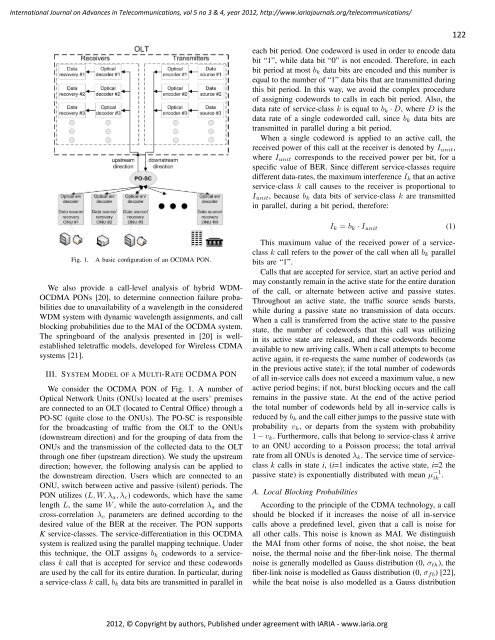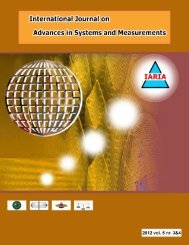download vol 5, no 3&4, year 2012 - IARIA Journals
download vol 5, no 3&4, year 2012 - IARIA Journals
download vol 5, no 3&4, year 2012 - IARIA Journals
Create successful ePaper yourself
Turn your PDF publications into a flip-book with our unique Google optimized e-Paper software.
International Journal on Advances in Telecommunications, <strong>vol</strong> 5 <strong>no</strong> 3 & 4, <strong>year</strong> <strong>2012</strong>, http://www.iariajournals.org/telecommunications/<br />
Fig. 1. A basic configuration of an OCDMA PON.<br />
We also provide a call-level analysis of hybrid WDM-<br />
OCDMA PONs [20], to determine connection failure probabilities<br />
due to unavailability of a wavelength in the considered<br />
WDM system with dynamic wavelength assignments, and call<br />
blocking probabilities due to the MAI of the OCDMA system.<br />
The springboard of the analysis presented in [20] is wellestablished<br />
teletraffic models, developed for Wireless CDMA<br />
systems [21].<br />
III. SYSTEM MODEL OF A MULTI-RATE OCDMA PON<br />
We consider the OCDMA PON of Fig. 1. A number of<br />
Optical Network Units (ONUs) located at the users’ premises<br />
are connected to an OLT (located to Central Office) through a<br />
PO-SC (quite close to the ONUs). The PO-SC is responsible<br />
for the broadcasting of traffic from the OLT to the ONUs<br />
(downstream direction) and for the grouping of data from the<br />
ONUs and the transmission of the collected data to the OLT<br />
through one fiber (upstream direction). We study the upstream<br />
direction; however, the following analysis can be applied to<br />
the downstream direction. Users which are connected to an<br />
ONU, switch between active and passive (silent) periods. The<br />
PON utilizes (L, W, λa, λc) codewords, which have the same<br />
length L, the same W , while the auto-correlation λa and the<br />
cross-correlation λc parameters are defined according to the<br />
desired value of the BER at the receiver. The PON supports<br />
K service-classes. The service-differentiation in this OCDMA<br />
system is realized using the parallel mapping technique. Under<br />
this technique, the OLT assigns bk codewords to a serviceclass<br />
k call that is accepted for service and these codewords<br />
are used by the call for its entire duration. In particular, during<br />
a service-class k call, bk data bits are transmitted in parallel in<br />
each bit period. One codeword is used in order to encode data<br />
bit “1”, while data bit “0” is <strong>no</strong>t encoded. Therefore, in each<br />
bit period at most bk data bits are encoded and this number is<br />
equal to the number of “1” data bits that are transmitted during<br />
this bit period. In this way, we avoid the complex procedure<br />
of assigning codewords to calls in each bit period. Also, the<br />
data rate of service-class k is equal to bk · D, where D is the<br />
data rate of a single codeworded call, since bk data bits are<br />
transmitted in parallel during a bit period.<br />
When a single codeword is applied to an active call, the<br />
received power of this call at the receiver is de<strong>no</strong>ted by Iunit,<br />
where Iunit corresponds to the received power per bit, for a<br />
specific value of BER. Since different service-classes require<br />
different data-rates, the maximum interference Ik that an active<br />
service-class k call causes to the receiver is proportional to<br />
Iunit, because bk data bits of service-class k are transmitted<br />
in parallel, during a bit period, therefore:<br />
Ik = bk · Iunit<br />
This maximum value of the received power of a serviceclass<br />
k call refers to the power of the call when all bk parallel<br />
bits are “1”.<br />
Calls that are accepted for service, start an active period and<br />
may constantly remain in the active state for the entire duration<br />
of the call, or alternate between active and passive states.<br />
Throughout an active state, the traffic source sends bursts,<br />
while during a passive state <strong>no</strong> transmission of data occurs.<br />
When a call is transferred from the active state to the passive<br />
state, the number of codewords that this call was utilizing<br />
in its active state are released, and these codewords become<br />
available to new arriving calls. When a call attempts to become<br />
active again, it re-requests the same number of codewords (as<br />
in the previous active state); if the total number of codewords<br />
of all in-service calls does <strong>no</strong>t exceed a maximum value, a new<br />
active period begins; if <strong>no</strong>t, burst blocking occurs and the call<br />
remains in the passive state. At the end of the active period<br />
the total number of codewords held by all in-service calls is<br />
reduced by bk and the call either jumps to the passive state with<br />
probability vk, or departs from the system with probability<br />
1 − vk. Furthermore, calls that belong to service-class k arrive<br />
to an ONU according to a Poisson process; the total arrival<br />
rate from all ONUs is de<strong>no</strong>ted λk. The service time of serviceclass<br />
k calls in state i, (i=1 indicates the active state, i=2 the<br />
passive state) is exponentially distributed with mean µ −1<br />
ik .<br />
A. Local Blocking Probabilities<br />
According to the principle of the CDMA tech<strong>no</strong>logy, a call<br />
should be blocked if it increases the <strong>no</strong>ise of all in-service<br />
calls above a predefined level, given that a call is <strong>no</strong>ise for<br />
all other calls. This <strong>no</strong>ise is k<strong>no</strong>wn as MAI. We distinguish<br />
the MAI from other forms of <strong>no</strong>ise, the shot <strong>no</strong>ise, the beat<br />
<strong>no</strong>ise, the thermal <strong>no</strong>ise and the fiber-link <strong>no</strong>ise. The thermal<br />
<strong>no</strong>ise is generally modelled as Gauss distribution (0, σth), the<br />
fiber-link <strong>no</strong>ise is modelled as Gauss distribution (0, σfb) [22],<br />
while the beat <strong>no</strong>ise is also modelled as a Gauss distribution<br />
<strong>2012</strong>, © Copyright by authors, Published under agreement with <strong>IARIA</strong> - www.iaria.org<br />
(1)<br />
122







